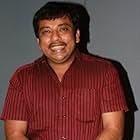Sanjay Ramaswamy, who is suffering from short-term memory loss, sets out on a quest to find and eliminate the people responsible for his ladylove Kalpana's murder.Sanjay Ramaswamy, who is suffering from short-term memory loss, sets out on a quest to find and eliminate the people responsible for his ladylove Kalpana's murder.Sanjay Ramaswamy, who is suffering from short-term memory loss, sets out on a quest to find and eliminate the people responsible for his ladylove Kalpana's murder.
- Awards
- 9 wins & 7 nominations
Storyline
Did you know
- TriviaThe story was adapted from Christopher Nolan's "Memento"
- ConnectionsFeatured in Sankham (2009)
Featured review
So the dust is beginning to settle for A. R. Murugadoss' Ghajini starring Aamir Khan, given that it had broken, and is still continuing to rake in stellar box office receipt records for a Bollywood movie around the world. For me, it piqued my interest enough to revisit his 2005 Tamil version starring Surya Sivakumar in the lead role, with Asin who also starred in both versions as Kalpana, and Pradeep Singh Rawat as the villain, curiously not called Ghajini here, but Laxman.
I shall leave comparisons with Christopher Nolan's Memento unmentioned because I've done so with my earlier review of Ghajini (2008).Instead I shall focus more on the similarities and differences in the Murugadoss films, since he crafted both the screenplay and dialogue, and directed both movies with predominantly the same leads, save for the protagonist Sanjay Ramasamy (Surya Sivakumar) inflicted with short term memory loss.
The opening credits stayed similar, and for the first half hour, I thought I would be watching the same 2008 movie all over again. I see the same policeman (Riyaz Khan) going through the same investigations and employing tactics seen before, and even the scene transitions relied on the same time lapse technique already seen. The structure of the story remained for at least two-thirds of the film, and especially the romance between Kalpana and Sanjay, except for distinct differences such as the knowledge of who the chief villain is with the possession of the all important polaroid, and spending some time showing how Sanjay had tattooed himself with the clues.
While it may be easy to work on a remake, given that you're basically rehashing what you've done before, and more so with experienced actors in the same role again, it is easy to free fall into complacency and to go through the motions with your own remake especially. But kudos to Murugadoss for identifying plot loopholes, and to make changes for the better in the Hindi version, rather than to import such flaws wholesale into the new movie. Obviously the production values were ramped up significantly from this version, but that's not the only thing that had improved. as was the editing.
The pace here is pretty much slower, and had plenty of fat which were removed in the latest version. Tweaks were done for the better in the latest, especially so in the editing department to gel scenes together much more effectively. Here, you get abrupt jumps and cuts, so the narrative turned out to be a bit choppy at times, especially so when it's time for the rudimentary song and dance sequence which pops out from almost nowhere. Sorely missed were the daily routine that Sanjay would have to relive everyday, which I thought was an important scene to reinforce his difficulty in trying to hunt down the gangsters.
The final act turned out to be an all out whackfest without too much thought put into making this film more plausible, opting instead for a pseudo-terrorist hostage situation. You could tell from the onset at this point that there were a few scenes Murugadoss would have elected to do differently, such as to avoid having Sanjay as a muscled and skilled fighter from the onset, with exaggerated Kollywood styled prowess to boot too. These were toned down for Bollywood, and having Aamir show off his six-packs from extreme training also helped to make it believable.
Murugadoss also decided to downplay and eliminate the complicated finale battle here, which made use of wire-fu, and his decision to change the that battle to that seen in the Hindi version, is much appreciated for creating a stronger sequence altogether. Even the very last scene of his reworked version fared miles better since it sent home some very strong emotional chords to the audience, rather than this version here which actually was quite creepy (my first thoughts were of reincarnation!)
Music wise, with all due respect to Haarris Jayaraj for his work here, I thought A.R. Rahman's actually worked better. The music here, while still effective, was a little downbeat, and the picturization (if that's what it's called) could have been vastly improved, many times being something like watching a tacky 80s made music video. Compare Guzarish and Sutrum Vizhi (which is my favourite song of the lot in this film), and you'll see what I mean. The placeholders for music to come on were pretty much the same, save for this version having what I thought was 2 distinct pieces reworked or removed totally from the remake for pace purposes. Sutrum Vizhi has this really hypnotic, head-banging beat to it.
My frank opinion would be to watch the Hindi version not because it's vastly superior, but for its production values as well as a more coherent story reworked for a much better result. This version is still valuable in terms of seeing how far everyone had come, and for fans of Asin, this is the film that provided her that breakthrough in her career.
The Region Free DVD by Venai Holdings is presented in matted letterbox format. Visual transfer is average at best, seemingly done off a VHS quality source. Toward the last hour there's this curious green tinge at the top right hand corner, but wasn't irritating enough to mar the enjoyment of the film. At times there were some pops and cackles in the visuals as well, but nothing too serious. Audio quality is in stereo and in the original language track, with English subtitles as an option. No other extra features contained in the DVD. Guess I shall wait for Ghajini 2008 to see if it comes with a special edition of sorts for some making of documentaries. Given the box office success, I don't see why not.
I shall leave comparisons with Christopher Nolan's Memento unmentioned because I've done so with my earlier review of Ghajini (2008).Instead I shall focus more on the similarities and differences in the Murugadoss films, since he crafted both the screenplay and dialogue, and directed both movies with predominantly the same leads, save for the protagonist Sanjay Ramasamy (Surya Sivakumar) inflicted with short term memory loss.
The opening credits stayed similar, and for the first half hour, I thought I would be watching the same 2008 movie all over again. I see the same policeman (Riyaz Khan) going through the same investigations and employing tactics seen before, and even the scene transitions relied on the same time lapse technique already seen. The structure of the story remained for at least two-thirds of the film, and especially the romance between Kalpana and Sanjay, except for distinct differences such as the knowledge of who the chief villain is with the possession of the all important polaroid, and spending some time showing how Sanjay had tattooed himself with the clues.
While it may be easy to work on a remake, given that you're basically rehashing what you've done before, and more so with experienced actors in the same role again, it is easy to free fall into complacency and to go through the motions with your own remake especially. But kudos to Murugadoss for identifying plot loopholes, and to make changes for the better in the Hindi version, rather than to import such flaws wholesale into the new movie. Obviously the production values were ramped up significantly from this version, but that's not the only thing that had improved. as was the editing.
The pace here is pretty much slower, and had plenty of fat which were removed in the latest version. Tweaks were done for the better in the latest, especially so in the editing department to gel scenes together much more effectively. Here, you get abrupt jumps and cuts, so the narrative turned out to be a bit choppy at times, especially so when it's time for the rudimentary song and dance sequence which pops out from almost nowhere. Sorely missed were the daily routine that Sanjay would have to relive everyday, which I thought was an important scene to reinforce his difficulty in trying to hunt down the gangsters.
The final act turned out to be an all out whackfest without too much thought put into making this film more plausible, opting instead for a pseudo-terrorist hostage situation. You could tell from the onset at this point that there were a few scenes Murugadoss would have elected to do differently, such as to avoid having Sanjay as a muscled and skilled fighter from the onset, with exaggerated Kollywood styled prowess to boot too. These were toned down for Bollywood, and having Aamir show off his six-packs from extreme training also helped to make it believable.
Murugadoss also decided to downplay and eliminate the complicated finale battle here, which made use of wire-fu, and his decision to change the that battle to that seen in the Hindi version, is much appreciated for creating a stronger sequence altogether. Even the very last scene of his reworked version fared miles better since it sent home some very strong emotional chords to the audience, rather than this version here which actually was quite creepy (my first thoughts were of reincarnation!)
Music wise, with all due respect to Haarris Jayaraj for his work here, I thought A.R. Rahman's actually worked better. The music here, while still effective, was a little downbeat, and the picturization (if that's what it's called) could have been vastly improved, many times being something like watching a tacky 80s made music video. Compare Guzarish and Sutrum Vizhi (which is my favourite song of the lot in this film), and you'll see what I mean. The placeholders for music to come on were pretty much the same, save for this version having what I thought was 2 distinct pieces reworked or removed totally from the remake for pace purposes. Sutrum Vizhi has this really hypnotic, head-banging beat to it.
My frank opinion would be to watch the Hindi version not because it's vastly superior, but for its production values as well as a more coherent story reworked for a much better result. This version is still valuable in terms of seeing how far everyone had come, and for fans of Asin, this is the film that provided her that breakthrough in her career.
The Region Free DVD by Venai Holdings is presented in matted letterbox format. Visual transfer is average at best, seemingly done off a VHS quality source. Toward the last hour there's this curious green tinge at the top right hand corner, but wasn't irritating enough to mar the enjoyment of the film. At times there were some pops and cackles in the visuals as well, but nothing too serious. Audio quality is in stereo and in the original language track, with English subtitles as an option. No other extra features contained in the DVD. Guess I shall wait for Ghajini 2008 to see if it comes with a special edition of sorts for some making of documentaries. Given the box office success, I don't see why not.
- DICK STEEL
- Jan 17, 2009
- Permalink
- How long is Ghajini?Powered by Alexa
Details
Box office
- Budget
- ₹120,000,000 (estimated)
- Runtime2 hours 55 minutes
- Color
- Sound mix
- Aspect ratio
- 2.35 : 1
Contribute to this page
Suggest an edit or add missing content



















